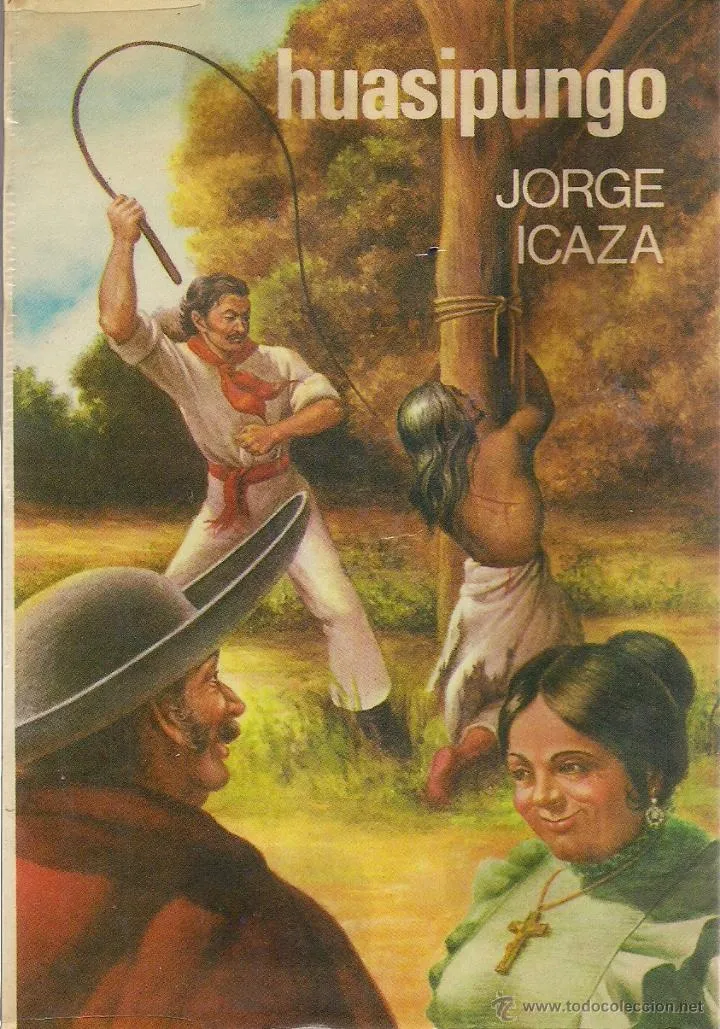The novel "Huasipungo" can claim
numerous merits: not only is it the magnum opus and most famous work
of its author, Jorge Icaza Coronel, it is also considered one of the
prime examples of indigenous literature of South America and the most
famous Ecuadorian novel. This is the book which made Coronel
world-famous and earned him invitations to numerous Latin
America-related forums, including by the State Department. According
to Wikipedia, the book has been compared to "Grapes of Wrath",
another novel with a social message.
For indeed, "Huasipungo" was meant
to draw attention to the plight of the Ecuadorian idigenous
population. The book was one of the first to include passsages
written entirely in Quechua, which I was oblivious to since I read
the book in translation.
To get the formal aspects out of the
way, this novel fits squarely into the realist literary tradition,
while at the same time being an indigenist work.
Cover art for "Huasipungo". Source: https://de.todocoleccion.net/gebrauchte-bucher-literatur/jorge-icaza-huasipungo-pepsa-eds-lecturas-para-una-hora-mexico-1975~x54972047
Plot
I will now outline the plot of the book
without including spoliers or going into much detail. If you want
that, there are plenty of summaries online which provide it.
Set in the 1910s, "Huasipungo" tells the story of Don Alfonso Pereira, an endebted landowner with
family problems. One day, his wealthy and business-savvy uncle
suggests that he convert his hacienda into a logging company and sell
it to a group of foreign investors who have taken an interest in the
region, drawn in by quality woods as well as the discovery of copious
amounts of oil. Pereira agrees and goes to the hacienda, where he
forces the Indios who live there to build a road, which is vital to
the planned conversion and involves draining a swamp, an arduous task
which claims the lives of several of the indigenous workers.
He later continues exploiting them,
even denying them the customary payment in crops which they have so
far received yearly, demanding that they work solely for the right to
live on the plots of land that belong to the hacienda and have been
lent them in feudal fashion, but which they have always considered
theirs (these plots are called huasipungos; hence the title). After Don Alfonso triggers a flood to drive the Indios out of
their huasipungos, conditions deteriorate for them. The landowner
grows wary that they may carry out an uprising. Tensions mount when
he sends in henchmen to drive them from their homes once more.
And then comes the ending, which I
shall not give away.
Critical assessment
One point I found interesting was the
fact that the author lived on his uncle´s hacienda between the ages
of three and six, which left a profound impression on him and made
him aware of the poverty and misery in which the Indios lived. Thus,
he later went on to denounce the coditions from which he himself had
profited, similarly to George Orwell.
Ecuadorian stamp with an image of Jorge Icaza. Source: https://es.wikipedia.org/wiki/Jorge_Icaza
So what did I
personally think of the book? I can definitely recommend it, the
least of its appeal arising from its relative shortness. It goes by more speedily than other literary portraits of time
periods, such as Charles Dickens´ books. So don´t worry about
wasting your earthly days on this novel; it can be finished in one or
two leisurely days.
Moreover, I was thrilled by Jorge
Icaza´s literary mastery. One review I found lauded his lively
descriptions of landscapes and scenery, and I agree that this is one
of the book´s strong points. Everything feels real and there is
never a cliché portrayal of anything. The palpable scenery
reoinforces "Huasipungo"´s social message, given the Indios´ close ties to their homes and their land.
Another aspect which I thoroughly
enjoyed was the use of foreshadowing. Throughout the book, the Idios
are shown to be docile and resigned to their servitude, but as Don
Alfonso ratchets up the pressure by forcing them to endure ever more
hardships, subtle indications that a rebellion bay be brewing begin
to shine through. These are things like grim flashes in the eyes,
reluctance to follow orders and so on. It kils two birds with one
stone by creating an ominous atmosphere as well as suggesting that in
oppressed classes, there can be a calm before the storm, with the
people appearing perfectly compliant until the last moment, until the
dam breaks.
I thought a clever little detail was
that as the book begins, the story focuses on Don Alfonso and his
point of view, which initially makes us sympathise with him, only to
despise him as he is later revealed to be an abusive racist and
becomes more and more depraved as he strives for ever-greater results
in his business endeavours.
Jorge Icaza often describes certain
matters as those characters, broadly speaking, who hold power see
them, which provides bitter irony as we realise how trivial their
problems and grievances are compared to those which they inflict on
the Indios.
It should also be noted that the
subject matter covered by the novel maintains relevance even today.
Although it was penned in 1934, the institution of the huasipungo was
only abolished around the end of the 1960s, meaning that there are
people alive today who lived in Ecuador while this feudalistic system
was still in place.
If you don´t want to read the book
itself, I recommend you watch the sixteen-minute short film made by a
handful of students for a school project. It is, however, in Spanish and cannot be a substitute
for reading the book itself.
Conclusion
In conclusion, read this book. Failing
that, watch the short film. Failing that, at least don´t immediately
forget the content of this post. Please.
Oh, who am I kidding. Like anyone´s
actually made it this far.
Sources used (excluding image sources)


Comments
Post a Comment